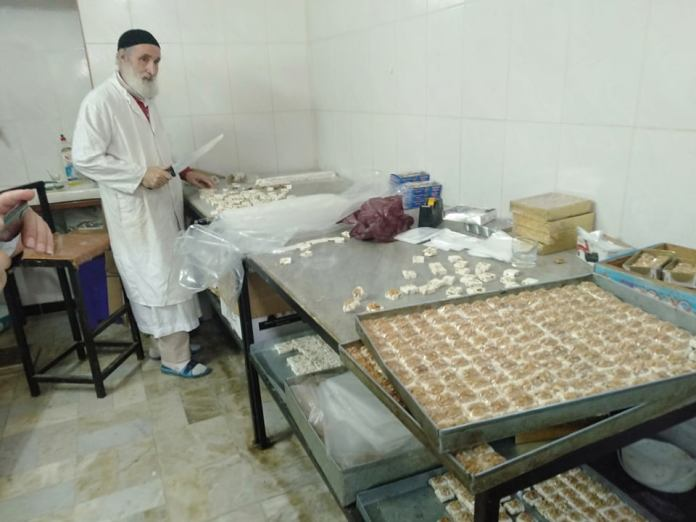Djouzia of Constantine, from ancestral know-how to the Algerian “trademark”
A real delight for the palate, Djouzia de Constantine, the fruit of ancestral know-how, has become a registered trademark on the Vieux Rocher. This tender and fragrant nougat, with a refined flavor, rich in honey, sprinkled with crushed walnuts is one of the most popular sweets in the city of a thousand and one delights.
Formerly prepared at home and reserved for moments of sharing and conviviality with family and friends, during Ramadan evenings, this incomparable delicacy has been propelled to the fore with the appearance of specialized factories.
It is now the “must” of ceremonies, receptions and wedding parties. La Djouzia has also become the ideal present that many Constantine residents offer to friends and visitors to the city.
La Djouzia, typical Constantine know-how and refinement
If the origins of Djouzia continue to fuel debate in the ranks of enthusiasts of the history of gastronomy of ancient Cirta, some agree that the preparation of this delicacy is "100% made in Constantine”.
As for pure honey, how could we deprive ourselves of it and do without its unique flavor when we know that the locality of Hamma-Bouziane (formerly called Hamma-Plaisance for its countless gardens) was a real paradise for beekeepers. Regarding its “distant” origins, if opinions remain divided, many specialists evoke a Persian origin. The Djouzia would then have been introduced by the Turks. But all of this remains questionable.
Its preparation in Constantine families was once a moment of joy, exchanges and conviviality like no other. Ms. Afifa Cherouana, pastry chef, specialist in the Constantinian culinary art, says that Djouzia was once prepared a few days before the month of Ramadan.
In Constantine, the djouzia still keeps the secrets of its flavor | Credit: 24hdz.com
Pure honey, brown sugar, egg whites and the best walnut kernels on the market were the main ingredients of the real Djouzia, says this professional. On a "Tabouna" (a kind of gas washing machine which is also used to prepare the cake), the honey and sugar are brought to a boil in a very deep "tandjra" in red copper, releasing exquisite hints which perfume the whole home, recalls Ms. Cherouana.
Beaten egg whites are gradually incorporated into honey and sugar before the mixture is flooded with crushed walnuts, she explains, before adding the dough thus obtained, of a beautiful light golden color. , stuffed with walnuts, was then spread out in a copper “s'nioua” (tray) then cut into diamonds, squares or sticks.
To prepare a good and authentic Djouzia, dexterity and know-how are "indispensable" say in unison all the professionals specialized in the preparation of this delicacy.
A good temperature when boiling honey and sugar, incorporating egg whites at the right time, without stopping to stir the dough are "the little secrets" of a succulent Djouzia, the one that releases the sweet taste honey and the incomparable flavor of nuts, say professional pastry chefs.
Djouzia was, in many families of the city of bridges, the undisputed (and unavoidable) “star” of Ramadan evenings, says Ms. Cherouana, before pointing out that the excessively expensive cost of the ingredients of this delicacy meant that Djouzia n t was present only during the holy month, a period when one could afford “additional expenses”.
A delicacy now “democratized”
E nz5skWEAUEgnnThis once out of reach delicacy is no longer the prerogative of wealthy people. It has become, over the years, a kind of "art of living" thanks to the proliferation of factories specializing in its preparation.
Many small workshops are now well established in the old town of ancient Cirta and their order books are always well stocked, especially at the approach of the holy month. “Chez Ahmed”, in a residential area of the city, is one of the most authentic addresses when it comes to making Djouzia. Here, we are assured that the key element is “respect for the quality of the basic ingredients”.
The shop receives orders from all over the country, and even from abroad, throughout the year. The kilo of Djouzia is charged at 2,000 dinars. By the piece, you have to go from 70 dinars.
? How many calories in Djouzia of Constantine
100 g of djouzia contain up to 421 kcal, enough to cause a small weight gain after a large consumption. This same portion of djouzia also contains 16 g of lipids and 63 g of carbohydrates. If you love djouzia, you will have to moderate the daily amount you consume, especially when you are on a diet.
Source: websites



